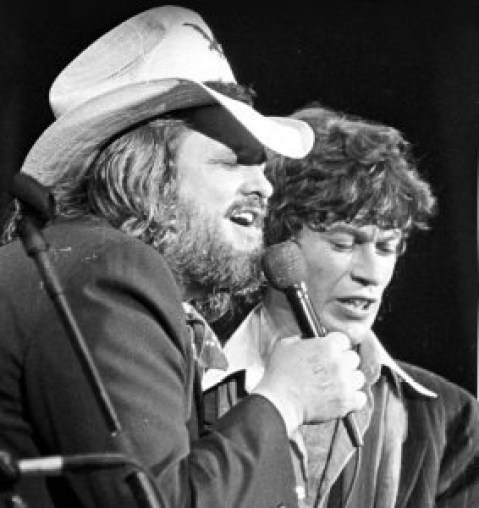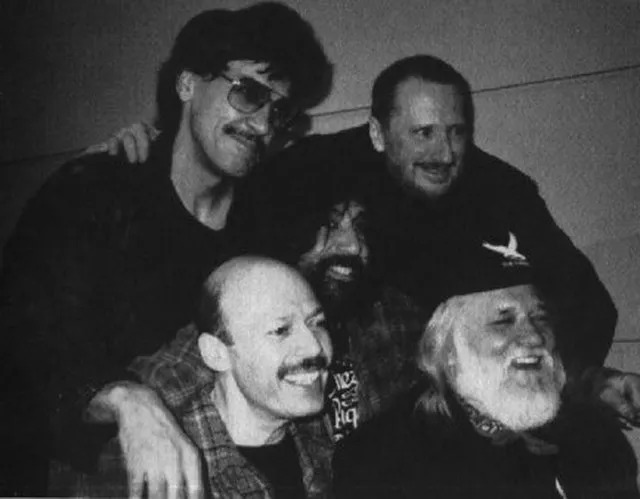Known as The Hawk, Ronnie Hawkins helped put rockabilly, The Band, and even Canada on the musical map.
Photo: Ronnie Hawkins in 1982. His style, Robbie Robertson said, was to play “faster and more violent and explosive than anyone had ever heard before.” Credit…Frank Lennon/Toronto Star
31 May 2022 | Clipper Media News

to meet with Prime Minister Pierre Trudeau in December 1969.
Left to right: John Lennon, Yoko Ono, Anthony Fawcett (kneeling),
John Brower (promoter), Wanda Hawkins, Ronnie Hawkins, and Ritchie Yorke.
Ronnie Hawkins, Rockabilly Road Warrior, Is Dead at 87
29 May 2022 | Peter Applebome | New York Times | With additional information added
Ronnie Hawkins, who combined the gregarious stage presence of a natural showman and a commitment to turbocharged rockabilly music in a rowdy career that spanned more than a half-century, died on Sunday. He was 87.
His daughter Leah confirmed his death. She did not say where he died or disclose the cause, though she said he had been quite ill.
Mr. Hawkins started performing in his native Arkansas in the late 1950s and became a roadhouse entertainer based in Canada in the 1960s, his music forever rooted in the primal rock ’n’ roll rhythms of Bo Diddley and Chuck Berry.

For all of his success, his biggest claim to fame was not the music he produced but the musicians he attracted and mentored. His backup musicians of the early 1960s, Levon Helm, Robbie Robertson, Garth Hudson, Richard Manuel and Rick Danko, went on to form the Band, which backed Bob Dylan and became one of the most admired and influential bands in rock history.
But those musicians, like many of Mr. Hawkins’s fans, never lost their reverence for the man known as the Hawk.
“Ronnie’s whole style,” Mr. Robertson once said, was for him and his band to play “faster and more violent and explosive than anyone had ever heard before.”
Ronald Cornett Hawkins was born on Jan. 10, 1935, two days after Elvis Presley, in Huntsville, Ark. When he was 9, his family moved to nearby Fayetteville, where his father, Jasper, opened a barbershop and his mother, Flora, taught school.
His musical education began at the barbershop where a shoeshine boy named Buddy Hayes had a blues band that rehearsed with a piano player named Little Joe.
It was there that he began to imbibe the crazy quilt music of the South, with blues and jazz filtered through snatches of country and the minstrel and medicine shows that traveled through town. Before long, something new was added: the beginnings of rock ’n’ roll, which was percolating out of Sam Phillips’s Sun Records studio in Memphis.
Mr. Hawkins brought to all that an element of danger. As a teenager, he had driven a souped-up Model A Ford running bootleg whiskey from Missouri to the dry counties of Oklahoma, making as much as $300 a day.
He put together bands, enrolled in the University of Arkansas and dropped out, joined the Army in 1957 and then quit the same year, intent on making it in the music business. While in the Army, he fronted a rock ’n’ roll band, the Black Hawks, made up of African American musicians, a daring effort in the segregated South.

Demos he recorded at Sun after he left the Army fell flat, but Mr. Hawkins and the guitarist on his Sun session, Luke Paulman, put together a band with Mr. Hawkins as the athletic frontman given to back flips and handstands.
Over the years, his trademark became the camel walk, an early version of what became Michael Jackson’s moonwalk decades later.
In 1958, the country music singer Conway Twitty said American rock ’n’ roll bands could make a killing in Canada. Heeding that advice, Mr. Hawkins moved to a place he once said was “as cold as an accountant’s heart.” Toronto and other places in Ontario turned into his home base for the rest of his career.
Mr. Hawkins liked to talk, perhaps with some embellishment, about parties, brawling, sex and drinking that, as he put it, “Nero would have been ashamed of.” But there was nothing glamorous about being a rock ’n’ roll musician playing nonstop in bars and roadhouses on a circuit centered on Ontario, Quebec and U.S. cities like Buffalo, Detroit and Cleveland.
“When I started playing rock ’n’ roll,” he said, “you were two pay grades below a prisoner of war.”
He built up a following based on his magnetic stage presence, the proficiency of his bands and the raw energy of his music. He had modest hits with “Forty Days” — his revised version of Chuck Berry’s “Thirty Days” — and “Mary Lou,” a Top 30 hit on the U.S. charts.
Later successful recordings include “Who Do You Love?” and “Hey, Bo Diddley.”

Morris Levy of Mr. Hawkins’s label, Roulette Records, billed him as someone who “moved better than Elvis, he looked better than Elvis and he sang better than Elvis.”
He saw a vacuum that he thought Mr. Hawkins could fill as the original rockabilly artists slowed down or flamed out. But Mr. Hawkins was not so sure, as he watched clean-cut teen idols like Frankie Avalon, Fabian and Bobby Rydell take over from their more rough-hewed progenitors.
To Mr. Levy’s chagrin, Mr. Hawkins opted to own the road in Canada rather than to swing for the fences as a recording star in the U.S., building up a remunerative career working nonstop, even though he never built a high-profile recording career.

Produced by Jerry Wexler & Tom Dowd
He also became known as a one-of-a-kind character and raconteur.
“The Hawk had been to college and could quote Shakespeare when he was in the mood,” Mr. Helm wrote in his autobiography, “This Wheel’s on Fire.” “He was also the most vulgar and outrageous rockabilly character I’ve ever met in my life. He’d say and do anything to shock you.”
Mr. Hawkins was more than just the consummate rockabilly road warrior. In 1969, he hosted John Lennon and Yoko Ono at his ranch outside Toronto during their world tour to promote world peace as the Plastic Ono Band. Bob Dylan was a longtime fan who in 1975 cast Mr. Hawkins to play the role of “Bob Dylan” in his experimental and largely panned movie “Renaldo and Clara.”
Mr. Hawkins also appeared in Martin Scorsese’s 1978 concert film “The Last Waltz,” as one of the invited stars who joined the Band in the final performance of the original group at Winterland Ballroom in San Francisco on Thanksgiving Day, 1976. (The Band later reunited without Mr. Robertson.)

Mr. Hawkins growled and hollered his way through a memorable performance with the Band of “Who Do You Love,” good-naturedly fanning Mr. Robertson’s guitar with his cowboy hat as if cooling it off after a particularly torrid solo.
And he became a friend of his fellow Arkansan Bill Clinton when Mr. Clinton was governor, as well as a conspicuous part of the Arkansas entourage during President Clinton’s Inaugural in 1992. Mr. Clinton paid tribute to Mr. Hawkins in a 2004 documentary titled “Ronnie Hawkins Still Alive and Kickin’.’’

Mr. Hawkins also acted in a supporting role in Michael Cimino’s critically panned 1980 western “Heaven’s Gate,” and he became a respected elder statesman of Canadian music.
He invested wisely, lived like a country squire in a sprawling lakefront estate and owned several businesses.
Besides his daughter Leah, survivors include his wife, Wanda, and two other children, Ronnie Jr. and Robin, and four grandchildren.
Mr. Hawkins remained a master of honing his bad-boy image and playing to type, including in his 1989 autobiography, “Last of the Good Ol’ Boys.”
“Ninety percent of what I made went to women, whiskey, drugs and cars,” he said. “I guess I just wasted the other 10 percent.”
Livia Albeck-Ripka contributed reporting.
Ronnie Hawkins Mourned By The Band’s Robbie Robertson

Robbie Robertson issued a statement about the band’s mentor, published here in its entirety.
“My heart sank when I heard “The Hawk” just flew into the sunset,” it read. “The story of The Band began with Ronnie Hawkins. He was our mentor. He taught us the rules of the road.
“Ronnie Hawkins brought me down from Canada to the Mississippi delta when I was 16. He recorded two songs I’d written and thought I might be talented. He tried me out on guitar and bass the only problem was; I’m too young to play in the clubs they toured, I was too inexperienced, not a good enough musician yet, and there are NO Canadians in southern rock and roll bands. But I practiced until my fingers were bleeding and he ended up hiring me against all odds.
“Ron prided himself in always having top notch players in his group. Levon Helm his drummer in the Hawks and I talked Ron into hiring Rick Danko on bass and vocals, Richard Manuel on piano and vocals and Garth Hudson on organ and sax. Along with Levon and me this became the magic combination.
“Ronnie was the godfather. The one who made this all happen.
“He had us rehearsing constantly into the wee hours. We balked about it, but we got better and better. Our goal whether we knew it or not.
“After the Hawks left Ron and went out on our own, we joined up with Bob Dylan. Next the Hawks became The Band and the rest is history, as they say.
“All starting out with Ronnie Hawkins.
“He was not only a great artist, a tremendous performer and bandleader, but had a style of humor unequaled. Fall down funny and completely unique. Yep, God only made one of those. And he will live in our hearts forever.
“My deepest condolences to his family.
“Bless his soul.”
These photos courtesy of
www.head-fi.org


From Ronnie’s Bio courtesy of a big Ronnie fan:
www.head-fi.org
“In 1969, John Lennon and Yoko Ono stayed with Ronnie on his farm in Mississauga for a couple of weeks during their peace crusade and took the Hawkins’ on their train ride to see Canada’s Prime Minister, Pierre Trudeau. Afterwards (remember the bed-in!), Ronnie and music journalist Ritchie Yorke were recruited by Lennon as peace emissaries and visited China. When Ronnie went to Muscle Shoals, Alabama, and recorded ‘Down In The Alley’ with Duane Allman in 1970, Lennon helped boost the single and recorded a promotional spot for it.”



photo caption: “The Hawk in 1996 at the Juno Awards, with Hall of Fame inductees
John Kay of Steppenwolf, Denny Doherty of The Mamas and The Papas, Zal Yanovsky of The Lovin’ Spoonful and Domenic Troiano of Mandala and The James Gang. Ronnie received the Walt Grealis Special Achievement Award for a Lifetime Contribution to Canadian Music”
![]()
